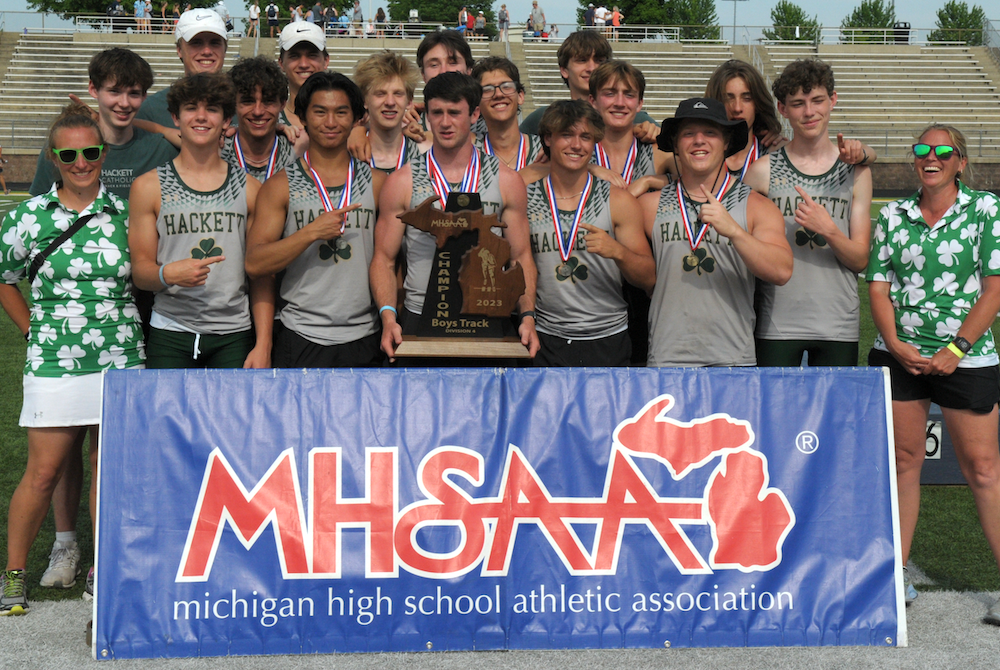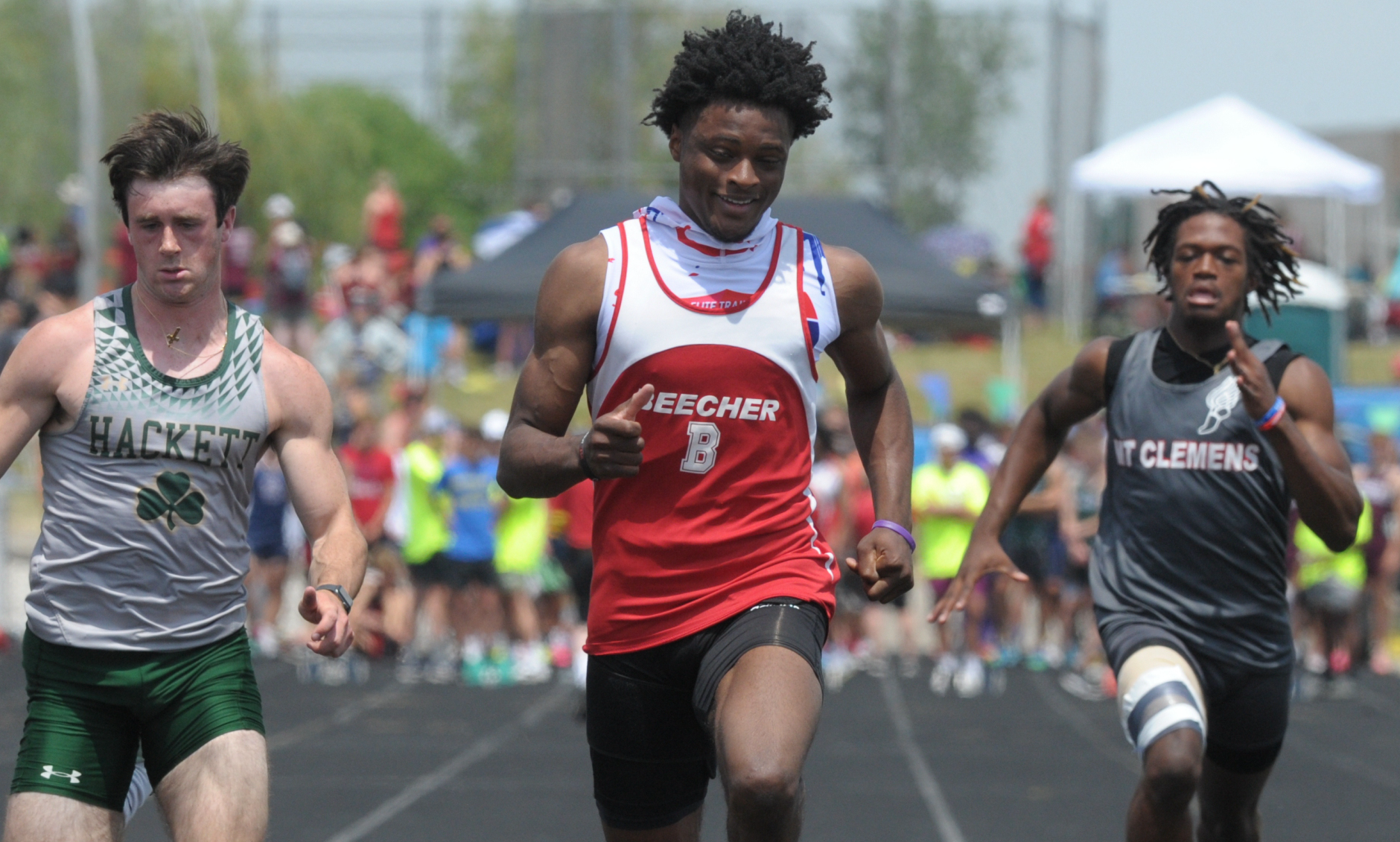
Kelloggsville Shines in First Title Run
June 1, 2013
By Geoff Mott
Special to Second Half
COMSTOCK PARK – Saturday’s Lower Peninsula Division 3 Boys Track and Field Finals just kept getting better and better for Wyoming Kelloggsville senior T.J. Burnett.
First he won the 400-meter dash title in 48.59 seconds, a mark he thought was well short of the LP Division 3 meet record.
“Coach had told me that 47.9 was the record, and when I got that time, I was pretty disappointed,” Burnett said. “Then I’m getting my medal, and I found out that I set the record.”
Then Burnett went out and helped his team win the 800 relay in 1:31.10 and close the meet with a title in the 1,600 relay (3:24.27).
And then Burnett found out the Rockets had captured their first-ever team title in track and field.
Wyoming Kelloggsville scored 52 points to easily outdistance runner-up Mason County Central (31) and third-place Standish-Sterling (28).
“The individual medals feel great, but nothing is better than winning that team title,” said Burnett, who immediately celebrated with family that numbered more than 10, including his sister from Texas.
Kelloggsville coach Tom DeGennaro has coached for 27 years, including the last three with the Rockets. It’s his first MHSAA title and a gratifying one at that.
“This group is special and full of outstanding kids,” DeGennaro said. “I can think of a lot of kids over the years that have helped build into this. But these kids are just awesome. They are gifted, but they also have great attitudes.”
DeGennaro pointed to athletes like Dionte Williams, who finished fourth in the 800 and ran legs for both relay title teams.
“He’s capable of competing in anything,” DeGennaro said. “He filled in for an injured kid in the 400 relay. He competed in the long jump this year.”
DeGennaro also was pleased to see Burnett come out on top.
“I saw something special in him the moment I took over the team,” DeGennaro said. “This has been a wonderful four-year journey for him. He’s a bulldog on the track and in the classroom, where he’s a 4.0 student.”
After a second-place finish in the 1,600 run last year, Mason County Central junior Chase Barnett wasn’t coming home without hardware this year. He won the race with a 4:15.97 finish, then added another win in the 800 run in 1:57.41.
“All the glory to God because I’m feeling pretty blessed right now,” Barnett said. “I really felt stronger this year. There was weird weather that kind of shortened up the season, but we figured out new ways to train and get the job done.
“I put in a lot of miles in the winter for this.”
Barnett brought home three championship medals, anchoring a Mason County Central title in the 3,200 relay – the team crossed with a 7:57.04 finish, nearly 17 seconds better than its qualifying time of 8:14.
“Now it’s time to go home and relax,” Barnett said.
Warren Michigan Collegiate senior Teo Redding glanced at the qualifying times heading into Saturday’s 110 hurdles and wasn’t sold on the 15.5-second time that had him seeded 19th in the event.
“I took second last year, and I’ve had better times than that,” Redding said. “Seeing that time made me even more hungry. I’ve been waiting all year for this. I was ready to go.”
Redding won his first MHSAA title and claimed the first title in school history, finishing the race in 14.65 to clip Burnett’s 14.77 finish. Redding took second in the long jump, clearing 6-8 on his first attempt, and also took second in the 300 hurdles with a 39.7 finish. Bangor’s Jesse Ring won the event in 39.17.
“I ran a really clean race,” Redding said. “I took off fast and wanted to leave (the field) as far behind as I could. It still came down to a photo finish.”
Redding, 18, will play football and hopes to run track next year at Bowling Green University.
Morley-Stanwood senior Travis McCuaig claimed back-to-back titles in the high jump, clearing 6-9 to edge Redding. McCuaig finished with three medals on the day, finishing fifth in the 300 hurdles (40.39) and eighth in the 110 hurdles (15.95).
“It’s funny because I’ve been down in the high jump and I changed some things this week,” McCuaig said. “I’m a power jumper, not a speed jumper. I’ve found I was running too hard and running into the pole. So I slowed it down today and got 6-7 on my first jump.
“Then Redding hit 6-8 on his first attempt, and I thought I was in trouble. I finally got it on my last attempt and then nailed 6-9 on my first attempt. I peaked at the right time this week.”
The 100 meter dash was decided by one hundredth of a second, and the third-place finisher was just three hundredths of a second from the top spot. In fact, one tenth of a second is all that separated the winner from fifth place.
But prevailing as champion was Southfield Bradford Academy senior Alize Champion. His 11.03 finish edged runner-up Jonathan Fife of Flint Southwestern and Carrollton’s Landon Lyons.
“Once I hit 50 meters, my long strides started to kick in,” said Champion, who placed eighth in the event last year and was seeded 22nd heading into Saturday. “I just had to give it my all because I knew this race was very competitive. There was a little pressure.”
The most interesting title went to Watervliet senior Jake Cowsert, who won the long jump with a 21-foot-1½ inch leap. He edged Pewamo-Westphalia’s Andy Pung by a half inch.
Cowsert didn’t compete in track and field until this season. After setting the long jump school record in middle school, all Cowsert wanted to do this year was set the high school record in the event and continue playing with the baseball team.
While his baseball team competed in Districts, Cowsert found a way to win a Finals championship.
“This is unbelievable,” said Cowsert, who’ll play football at Olivet College. “Our school doesn’t like us to compete in multiple sports in a season, but I really wanted the record.
“I didn’t even know what it took to win a state title or what the marks were. I broke the school record in the fourth meet of the season and just kept going. I graduated last night, and now I’m a state champion. Unbelievable.”
Bath senior Jeff Dempsey improved his pole vault by nearly a foot, winning the event with a 14-foot, 7-inich vault after qualifying with a 13-9 in the event. He finished third in 2012.
“I couldn’t be happier right now,” said Dempsey, who next heads to Pensacola Christian College (Fla.) to major in pastoral studies. The school doesn’t have pole vault. “It’s a great way to end a career. It feels great for the personal accomplishment, but I love for God. He gets the glory.”
Dempsey also credited pole vault coach Jerry Sessions from Maple Valley. Dempsey started training with the coach as a sophomore, improving his vault from 12-6 to 14-7.
“He did a tremendous job and gave me a lot of confidence to compete at this level,” Dempsey said. “He brought me a pole that worked very well.”
Niles Brandywine’s Evan Hartman won the discus with an LP Division 3 Finals record of 187-1, while Standish-Sterling’s Clayton Walderzak won the shot put with a toss of 55-2½.
Saginaw Nouvel Catholic Central’s Tyler Hendricks bounced back from horrible injuries a year ago to win the 200 dash in 22.82, while Lansing Catholic’s Rebera Keenan won the 3,200 title in 9:32.46.
Ann Arbor Gabriel Richard won the 400 relay in 43.99.
PHOTO: Wyoming Kelloggsville won the 800 and 1,600-meter relays on the way to claiming the overall team championship at Comstock Park. (Photo by Jackie Gomez. Click to see more photo coverage from RunMichigan.com.)

Thrower Claims Lone Individual Title to Lead Hackett to Team 3-Peat
By
Tom Lang
Special for MHSAA.com
June 3, 2023
Kalamazoo Hackett Catholic Prep just keeps winning and winning.
This time the Irish took home their fourth title in the last five Lower Peninsula Division 4 Track & Field Finals, on Saturday at Hudsonville.
Hackett’s only individual title was taken by discus winner Nathan Buchmann, a senior, who was fine knowing he was the shortest in stature among all the sizable competitors.
“In the offseason after football I worked out every day, working towards this goal,” he said after getting his medal. “I would say this takes 80 percent technique and 20 percent strength to throw the discus. So, length can help but if you have good technique and are really strong, that will play into it.
“I think we are very balanced throughout the meet today,” he said about teammates that scored points in finishes other than first place. “We have 13 guys here today, and we have people in a lot of the races. But I do not run; I have too short of legs to be a fast runner,” he said with a chuckle.
Buchmann had to work through a hip injury to compete this spring.
“I think the setbacks are what make you strong,” he said. “You can either give up through the setbacks or push forward and become better.”
 Coach Charissa Dean agreed.
Coach Charissa Dean agreed.
“The kids have big hearts,” she said after all the points were totaled and the Irish were on top once again, with 53. “They worked hard. They had a lot of potential when we started the season. And we had a lot of drive to put in the work, and we are happy the results came out the way they did.”
Reading was runner-up at 47 points, followed by Wyoming Potter’s House Christian with 42, then Fowler and Flint Beecher each with 37 points.
Senior Lezawe “Moses” Osterink, of Potter’s House Christian, placed second in 1,600 but took the 3,200 title as defending champ of both. He dominated the latter by lapping the field with a final lap kick that resembled more of a superhero speedster.
“Nobody really took it out that hard at the start,” he said. “There was a freshman (Marek Butkiewicz of Hackett) that tried to get the pace going quick, but me and Dakota (Dykhuis of Montabella) just kind of sat back and gradually pulled him through.
“We took it gradually, and I was just relying that I could kick.”
Kick did he ever. The trio were neck and neck the majority of the race in a grouping ahead of the pack.
“With 400 to go I just tried to go all out,” Osterink said. “I had a lot more left than I thought and I was pleased with the win. Not really the time, but that doesn’t matter, especially this hot out.”
The overall meet was in the low 90s/high 80s heat and searing sun all day. So, race officials allowed the unique opportunity for coaches to spray the runners with water and give them water bottles.
“It was very weird because I’ve never taken water to drink while I’m running, so I didn’t know how that would feel,” Osterink said. “And they were spraying us and hitting us in the face. It was kind of fun.”
Junior Tyler Lenn of Marine City Cardinal Mooney defeated Osterink at his own game in the 1,600.
“I’m feeling great,” Lenn said after grabbing the medal. “I said to a newspaper after one of my races (during the season) I was right where I wanted to be. This has been a long rebuilding process for me since an injury back in the fall, and I set a pretty high goal the day the injury happened. I was telling myself I needed to fulfill what I said I would do at the beginning of last cross country season. And that is what I did today.”
Lenn suffered an ankle sprain from a misstep that turned worse because he kept running through the season on it.
“Coming back from that was pretty tough, but I wouldn’t have it any other way,” he said.  “Perseverance; I said from the beginning what I was going to do. I kept my eye on that target, and no matter the circumstances life threw at me, that I was going to make it happen and I am a man of my word.”
“Perseverance; I said from the beginning what I was going to do. I kept my eye on that target, and no matter the circumstances life threw at me, that I was going to make it happen and I am a man of my word.”
Jaylin Townsend, a senior from Flint Beecher, dominated the short races. He won the 100 dash (10.67) and 200 dash at 22 seconds flat. It was his third 100 win at a Finals.
“I put in a lot of work; I had to three-peat,” he said after the 100. “There’s a lot of great competition here, so I knew I had to come out and run my best.”
Concord in the 400 (43.72), Buckley in the 800 (1:30.76) and 1,600 (3:29.13) and Potter’s House in the 3,200 (8:14.18) were relay champs Saturday. Reading’s Tayshawn Bester won the 110 hurdles (15.13), and Athens’ Landen Bennett won the 300 (39.85). Caseville’s Nathan Feltner won the 400 (50.76), and Vestaburg’s Owen Patton claimed the 800 (1:55.11).
Fruitport Calvary Christian’s Bradley Richards won the high jump (6-10), and Peck’s Alex Affer won the long jump (23-4). McBain Northern Michigan Christian’s Isaac Bowden was first in pole vault (13-0), and Brown City’s Kyle Affer won shot put (49-2).
PHOTOS (Top) Kalamazoo Hackett Catholic Prep celebrates its third-straight LPD4 title Saturday. (Middle) Cardinal Mooney's Tyler Lenn, far right, sets the pace in the 1,600. (Below) Flint Beecher's Jaylin Townsend, middle, crosses the finish first for one of his two sprint championships. (Photos by Ken Swart/RunMichigan.com.)

